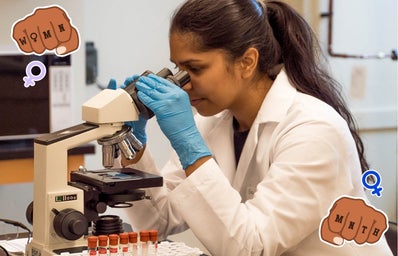History is full of women who made monumental contributions to science. Some of them are well-known, household names but others haven’t received the same recognition. In light of International Women’s Day, I want to celebrate the accomplishments of the remarkable women pioneers in STEM and highlight their ground-breaking discoveries. So, who are the women who changed the world through science, technology, engineering and mathematics? Today we’ll take a look at seven of them.
Cecilia Payne-Gaposchkin
Cecilia Payne-Gaposchkin was a British-American astronomer who discovered he composition of stars. Cecilia initially pursued her studies botany at university but that quickly changed when she heard a lecture about a solar expedition that proved Einstein’s Theory of Relativity. She subsequently changed her major to physics and enrolled herself in any astronomy courses that she could pick up.
After graduation, Cecilia was granted a fellowship at the Harvard College Observatory. By looking down through a small magnifying glass, she accomplished what many aimed to do by looking through a telescope, she determined that hydrogen was far more prevalent in the Universe than the astronomical community believed and that it was this element that primarily made up stars. However, no one believed that a female could make a discovery of this importance. Henry Norris Russell, the dean of American astronomers and the head of the Princeton Observatory at the time wrote to Cecilia and deemed her findings to be “clearly impossible.” Because of this, Cecilia doubted her own discovery and, in her book, stated that her results were “almost certainly not real.” Years later, Henry Russell recognized that Cecilia was in fact right.
Through all of this, Payne became the first woman to receive the American Astronomical Society’s “lifetime of eminence” award. Later on, in 1956, Harvard University appointed Cecilia as a professor of Astronomy. According to the New York Times, “She is the first woman to attain full professorship at Harvard through regular faculty promotion.”
Hedy LaMarr
Hedy LaMarr’s contribution to science is often overlooked because of her claim to fame as a prolific actress. LaMarr was also a gifted inventor. She co-invented an early version of frequency-hopping technology that became a precursor to Wi-fi, GPS and Bluetooth now used by people all over the world. However, LaMarr’s work as an inventor was hardly publicized in the 1940s, since having a female movie star be anything more than a box-office hit was not a notion that Hollywood could accept or project to its audiences.
LaMarr was born in Austria to Jewish parents and immigrated to the U.S. prior to the start of World War II. She caught the eye of Louis B. Mayer, the head of MGM studio, and negotiated a contract that would allow her to act in Hollywood films. She devoted her time free from acting to experiments that she would conduct in her trailer, and though this she discovered her passion for inventing. In 1941, LaMarr filed for a patent with her co-inventor George Antheil to protect their invention that would allow radio communications to ‘hop’ from one frequency to another. This enabled the Allied torpedoes to go undetected by the Nazis. However, to this day, LaMarr never got the recognition, nor any compensation for her creation despite the fact that the United States military publicly recognized her patent and contribution to technology.
Valentina Tereshkova
Valentina Tereshkova is a Russian engineer, and former cosmonaut. She is the first and youngest woman to travel into space. While being a textile worker and despite having no previous pilot training, Tereshkova was selected from a pool of 400 applicants because of her skill as an accomplished amateur parachutist. On this basis, she was accepted to the cosmonaut program and made space history by becoming the first woman in space. When launched into space on a solo mission in June of 1963, her aircraft completed 48 orbits in 71 hours before landing back to Earth. After her return to Earth, Tereshkova was named a Hero of the Soviet Union and continued to inspire many as a high-ranking member of government.
Jane Goodall
Dame Jane Goodall is an English primatologist and anthropologist. She is considered to be the world’s foremost expert on chimpanzees and is renowned for the discoveries she made about their behaviour over the course her 60-year study of social and family interactions of wild chimpanzees in Gombe Stream National Park, Tanzania. Through her study, she discovered that chimpanzees make tools, hunt for meat and have similar social behaviour to humans. Goodall’s research was instrumental to transforming people’s attitudes on wildlife conservation.
In fact, wildlife was of interest to Jane from an early age. Unable to attend university, Jane saved enough money by the age of 23 to travel to Kenya, where she met prominent anthropologist and paleontologist, Dr. Louis S. B. Leakey. Alongside Leakey, Goodall made great strides in primatology, a male-dominated field, at a time when the concept of a young woman working and studying animals seemed absurd. In 1965, she defied the odds to become one of the first people to obtain a PhD despite lacking a Bachelor’s degree. Throughout her career, she has published many books and founded the Jane Goodall Institute for Wildlife Research, Education and Conservation. Today, she continues to inspire future generations to be proactive about wildlife preservation and frequently spotlights pertinent issues like deforestation and animal cruelty.
Alice Augusta Ball
Alice Ball was an American chemist who developed the “Ball Method”, the most effective treatment for leprosy during the early 20th century. Ball was only 23 years old when she developed the treatment. She always displayed an aptitude for learning obtaining two Bachelor degrees from the University of Washington — first in pharmaceutical chemistry and the second in pharmacy. Ball went on to be published in the Journal of American Chemical Society, a renowned chemistry journal, for a paper she co-authored with her instructor. This was an unprecedented feat for a woman and especially for a Black woman at this time. Alice went on to obtain a master’s degree from the University of Hawaii and became the first African American to earn a master’s degree from the university and, later, she became the university’s first female and African American professor.
At the University of Hawaii, Ball investigated the chemical makeup of kava. Because of this, she was asked to assist Dr. Harry T. Hollmann in the research of leprosy treatment. At the time, leprosy was a highly stigmatized disease with no chance of recovery. The best treatment option however, was chaulmoogra oil but it wasn’t always successful in its natural form. Ball conducted research and successfully developed a method for deriving the active components from the oil. She chemically modified the compounds in the oil to preserve their therapeutic properties and improve their absorption in the body. Her work helped to treat patients suffering from leprosy for decades. Unfortunately, Ball died in 1916 at the age of 24 and Dr. Arthur Dean continued her research. He then published a paper using her work without crediting her. However, Dr. Hollman also published a paper later on, giving Ball credit for her ground-breaking work and naming the injectable form of the oil ‘the Ball Method’.
Pardis Sabeti
Dr. Pardis Sabeti is an American-Iranian computational geneticist who sequenced the Ebola genome when the epidemic began in West Africa in 2014. Dr. Sabeti led a team that successfully sequenced virus samples from infected patients as soon as the outbreak began and in doing so, lead the first real-time DNA sequencing in the midst of an urgent crisis. Her findings proved that the virus was indeed spreading from person to person — and not by means of a vector like mosquitoes. The project resulted in the deaths of several of her fellow colleagues and researchers but it also ended up saving many lives. She continues to use her expertise as a professor at the Center for Systems Biology and Department of Organismic and Evolutionary Biology at Harvard University and the Department of Immunology and Infectious Disease at the Harvard School of Public Health.
Özlem Türeci
Dr. Özlem Türeci is Turkish-German physician, scientist and entrepreneur who helped to design the Pfizer-BioNTech vaccine to combat COVID-19. She co-founded the German biotechnology company BioNTech in 2008 with her husband Dr. Ugur Sahin, which developed the first approved messenger RNA-based vaccine against the novel coronavirus. Dr. Türeci’s and Dr. Sahin’s vaccine was found to be 95% effective in preventing COVID-19 beginning one week after the second dose based on studies in about 44,000 participants. Dr. Türeci has served as BioNTech’s chief medical officer since 2018 and continues to do so in the midst of this pandemic.


